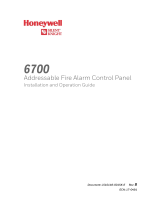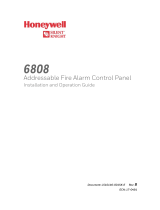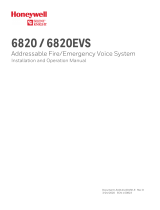Page is loading ...

1 I56-3889-003R
06-10
INSTALLATION AND MAINTENANCE INSTRUCTIONS
Low Frequency Sounder/Strobes
3825 Ohio Avenue, St. Charles, Illinois 60174
800/736-7672, FAX: 630/377-6495
www.systemsensor.com
For use with the following models: P2RH-LF, P2WH-LF, HR-LF, HW-LF
PRODUCT SPECIFICATIONS
Operating Temperature: 32°F to 120°F (0°C to 49°C)
Humidity Range: 10 to 93% Non-condensing
Strobe Flash Rate: 1 flash per second
Nominal Voltage (Low Frequency Sounder): Regulated 12VDC/FWR or regulated 24VDC/FWR
Nominal Voltage( Low Frequency Sounder/Strobe): Regulated 24VDC/FWR
Operating Voltage Range (includes fire alarm panels with built in sync): 8 to 17.5V (12V nominal) or 16 to 33V (24V nominal)
Operating Voltage with MDL3 Sync Module: 8.5 to 17.5V (12V nominal) or 16.5 to 33V (24V nominal)
Input terminal wire gauge: 12 to 18 AWG
DIMENSIONS FOR PRODUCTS AND ACCESSORIES
PRODUCTS LENGTH WIDTH DEPTH
Low Frequency Sounder/Strobes (including lens)
6.4˝ 4.7˝ 2.5˝
162 mm 119 mm 64 mm
Low Frequency Sounder
5.6˝ 4.7˝ 1.3˝
142 mm 119 mm 33 mm
Low Frequency Sounder Strobe with SBBR/SBBW Surface Mount Back Box
6.4˝ 4.7˝ 4.3˝
162 mm 120 mm 108 mm
Low Frequency Sounder with SBBR,
SBBW Surface Mount Back Box Length 5.7˝
5.7˝ 4.8˝ 3.0˝
145 mm 120 mm 76 mm
MOUNTING BOX OPTIONS
2-Wire Indoor Products
4 × 4 × 1
1
/2, Single Gang, Double Gang, 4˝ Octagon
GENERAL DESCRIPTION
The SpectrAlert Advance low frequency series of notification appliances offers
a range of low frequency sounder and low frequency sounder/strobe products
for wall and ceiling applications. Studies have shown that low frequency audi-
ble devices that operate around 520Hz are more effective in waking individuals
in sleeping areas. The sounder only version is designed for use in 12 or 24 volt,
DC or FWR (full wave rectified) systems. Sounder/Strobe versions are only
to be used with 24 volt, DC or FWR systems. These products are electrically
backward compatible with the previous generation of SpectrAlert notification
appliances. The 2-wire products fit systems where a single NAC controls both
sounder and strobe. The System Sensor MDL3 module may be used to provide
synchronization.
Models are approved for wall and ceiling installations.
FIRE ALARM SYSTEM CONSIDERATIONS
The National Fire Alarm Code, NFPA 72, requires that all sounders, used for
building evacuation produce temporal coded signals. Signals other than those
used for evacuation purposes do not have to produce the temporal coded sig-
nal. The National Fire Alarm Code, NFPA 72, will require effective Jan. 1, 2014
that audible appliances installed in sleeping areas produce a low frequency
alarm signal that shall be a square wave or provide equivalent awakening abil-
ity. System Sensor recommends spacing notification appliances in compliance
with NFPA 72.
LOOP DESIGN AND WIRING
The system designer must make sure that the total current drawn by the de-
vices on the loop does not exceed the current capability of the panel supply,
and that the last device on the circuit is operated within its rated voltage. The
current draw information for making these calculations can be found in the
tables within this manual. For convenience and accuracy, use the voltage drop
calculator on the System Sensor website (systemsensor.com/volt).
When calculating the voltage available to the last device, it is necessary to
consider the voltage drop due to the resistance of the wire. The thicker the
wire, the smaller the voltage drop. Wire resistance tables can be obtained
from electrical handbooks. Note that if Class A wiring is installed, the wire
length may be up to twice as long as it would be for circuits that are not
fault tolerant.
NOTE: The total number of strobes on a single NAC must not exceed 40 for
24 volt applications or 12 for 12 volt applications. Loop resistance on a single
NAC should not exceed 120 ohms for 24 volt and 30 ohms for 12 volt systems.
NOTE: A shorting spring is provided between terminals 2 and 3 of the mount-
ing plate to enable wiring checks after the system has been wired, but prior
to installation of the final product. This spring will automatically disengage
when the product is installed, to enable supervision of the final system.
Removal of a notification device will result in an open circuit indication on
the NAC.
I56-3889-003R
NOTICE: This manual shall be left with the owner/user of this equipment.

2 I56-3889-003R
06-10
MOUNTING INDOOR WALL OR CEILING PRODUCTS
1. Attach mounting plate to junction box as shown in Figures 3 and 4. The
mounting plate is compatible with 4-inch square, double gang, and 4-inch oc-
tagon junction boxes (2-wire products may be used with a single gang box).
2. Connect field wiring to terminals, as shown in Figures 1 .
3. If the product is not to be installed at this point, use the paint cover to
prevent contamination of the mounting plate. (For indoor models only)
4. To attach product to mounting plate, remove the paint cover, then hook
tabs on the product housing into the grooves on mounting plate.
5. Then, swing product into position to engage the pins on the product with
the terminals on the mounting plate. Make sure that the tabs on the back
of the product housing fully engage with the mounting plate.
6. Secure product by tightening the single mounting screw in the front
of the product housing. For tamper resistance, the standard captivated
mounting screw may be replaced with the enclosed Torx screw.
SURFACE MOUNT BACK BOX MOUNTING
1. The surface mount back box may be secured directly to the wall or ceil-
ing. Grounding bracket provided if needed.
2. The wall mount box must be mounted with the up arrow pointing up.
3. Threaded knockout holes are provided for the sides of the box for ¾ inch
and ½ inch conduit adapter. Knockout plugs in the back of the box can
be used for ¾ inch and ½ inch rear entry.
4. To remove the ½ inch knockout, we recommend you use a flat head
screwdriver and place the blade along the inner edge and work your way
around the knockout as you strike the screwdriver, as shown in Figure
7. To remove the ¾ inch knockout place the blade of the screwdriver
along the edge and work your way around the knockout as you strike the
screwdriver, as shown in Figure 8.
5. V500 and V700 wiremold raceways are also provided. Use V500 for low
profile applications and V700 for high profile applications.
6. To remove the wire mold knockout turn pliers up, as shown in Figure 9.
7. Attach the mounting plate to the surface mount back box using the four
unpainted screws, as shown in Figure 5 or 6.
8. Follow steps 2-6 of the mounting indoor wall or ceiling products to wire
and attach the product.
+
–
+
–
INPUT
FROM
F
ACP
OR
PRIOR
DEVICE
OUTPUT
TO
NEXT
DEVICE
OR EOL
WIRING DIAGRAMS
FIGURE 1. WIRING 2-WIRE PRODUCTS:
A0367-01
SHORTING SPRING
A0368-00
SBB Shown
FIGURE 2. SHORTING SPRING:
2-wire mounting plate
Models are approved for Wall
and Ceiling installations.
A0453-00
A0454-00
FIGURE 3. WALL MOUNT LF SOUNDER:
FIGURE 4. WALL MOUNT LF SOUNDER/STROBE PRODUCT:
FIGURE 5. WALL MOUNT LF SOUNDER WITH
SURFACE MOUNT BACK BOX:
FIGURE 6. WALL MOUNT LF SOUNDER/STROBE
WITH SURFACE MOUNT BACK BOX
A0455-00
A0456-00

3 I56-3889-003R
06-10
TABLE 2. 2-WIRE LOW FREQUENCY SOUNDER/STROBE CURRENT DRAW (mA) FOR P2H-LF HIGH CANDELA RANGE SERIES:
Sound Pattern
16–33 Volts DC 16–33 Volts FWR
135 cd 150 cd 177 cd 185 cd 135 cd 150 cd 177 cd 185 cd
Temporal 277 292 325 344 296 309 343 351
Continuous 337 362 387 417 393 395 432 433
TABLE 3. LOW FREQUENCY SOUNDER OUTPUT (dBA) IN REVERBERANT (UL**):
Switch
Position
Sound Pattern
8–17.5 Volts** 16–33 Volts**
DC FWR DC FWR
1 Temporal 76 76 76 76
2 Continuous 80 80 80 80
3* Coded 80 80 80 80
*Sounder ratings provided are for continuous voltage as provided by the NAC.
** Minimum dB rating for Operational Voltage Range as per UL 464.
A0459-00
A0460-00
A0461-00
CANDELA SELECTION
Adjust the slide switch on the rear of the product to position the desired can-
dela setting in the small window on the front of the unit. All products meet
the light output profiles specified in the appropriate UL Standards. Refer to
Figures 10-12.
SOUNDER SELECTION
Turn the rotary switch on the back of the product to the desired setting. For
sounder and sounder/strobe products (P2H-LF series), current draws are
listed in Tables 1 and 2. The sound output measurement for each sounder
setting is shown in Table 3.
FIGURE 9. V500 AND V700 WIRE MOLD REMOVAL FOR SURFACE
MOUNT BACK BOX
FIGURE 7. ½ INCH KNOCKOUT REMOVAL FOR SURFACE MOUNT BACK
BOX
FIGURE 8. ¾ INCH KNOCKOUT REMOVAL FOR SURFACE MOUNT BACK
BOX
TABLE 1. SOUNDER CURRENT DRAW (mA) FOR H-LF SERIES:
Position Sound Pattern
8–17.5 Volts 16–33 Volts
DC FWR DC FWR
1 Temporal 191 262 138 166
2 Continuous 292 384 138 208
3 Coded 292 388 153 205
NOTE: In position 3, temporal coding must be provided by the NAC. If the
NAC voltage is held constant, the sounder output will remain constantly on.
Coded ratings provided are for continuous voltage. Position 3 is not available
on 2-wire low frequency sounder/strobe products.

4 I56-3889-003R
©2016 System Sensor. 06-10
The sounder and/or strobe will not work without power. The sounder/strobe gets its
power from the fire/security panel monitoring the alarm system. If power is cut off for
any reason, the sounder/strobe will not provide the desired audio or visual warning.
The sounder may not be heard. The loudness of the sounder meets (or exceeds) cur-
rent Underwriters Laboratories’ standards. Studies have shown that the low frequency
sounder (520Hz) is more effective at waking individuals in sleeping spaces, especially
individuals that may have recently used drugs or drinking alcoholic beverages. The
sounder may not be heard if it is placed on a different floor from the person in hazard or
if placed too far away to be heard over the ambient noise such as traffic, air conditioners,
machinery or music appliances that may prevent alert persons from hearing the alarm.
The low frequency sounder may not be heard by persons who are hearing impaired.
NOTE: Strobes must be powered continuously for sounder operation.
The signal strobe may not be seen. The electronic visual warning signal uses an extremely
reliable xenon flash tube. It flashes at least once every second. The strobe must not be in-
stalled in direct sunlight or areas of high light intensity (over 60 foot candles) where the visual
flash might be disregarded or not seen. The strobe may not be seen by the visually impaired.
The signal strobe may cause seizures. Individuals who have positive photoic response
to visual stimuli with seizures, such as persons with epilepsy, should avoid prolonged
exposure to environments in which strobe signals, including this strobe, are activated.
The signal strobe cannot operate from coded power supplies. Coded power supplies
produce interrupted power. The strobe must have an uninterrupted source of power in
order to operate correctly. System Sensor recommends that the sounder and signal strobe
always be used in combination so that the risks from any of the above limitations are
minimized.
THE LIMITATIONS OF LOW FREQUENCY HORN/STROBES
WARNING
THREE-YEAR LIMITED WARRANTY
System Sensor warrants its enclosed product to be free from defects in materials and
workmanship under normal use and service for a period of three years from date of
manufacture. System Sensor makes no other express warranty for this product. No
agent, representative, dealer, or employee of the Company has the authority to increase
or alter the obligations or limitations of this Warranty. The Company’s obligation of this
Warranty shall be limited to the replacement of any part of the product which is found to
be defective in materials or workmanship under normal use and service during the three
year period commencing with the date of manufacture. After phoning System Sensor’s
toll free number 800-SENSOR2 (736-7672) for a Return Authorization number, send
defective units postage prepaid to: Honeywell, 12220 Rojas Drive, Suite 700, El Paso TX
79936, USA. Please include a note describing the malfunction and suspected cause of
failure. The Company shall not be obligated to replace units which are found to be defec
-
tive because of damage, unreasonable use, modifications, or alterations occurring after
the date of manufacture. In no case shall the Company be liable for any consequential
or incidental damages for breach of this or any other Warranty, expressed or implied
whatsoever, even if the loss or damage is caused by the Company’s negligence or fault.
Some states do not allow the exclusion or limitation of incidental or consequential dam
-
ages, so the above limitation or exclusion may not apply to you. This Warranty gives you
specific legal rights, and you may also have other rights which vary from state to state.
FCC STATEMENT
SpectrAlert Strobes and Low Frequency Sounder/Strobes have been tested and found
to comply with the limits for a Class B digital device, pursuant to part 15 of the FCC
Rules. These limits are designed to provide reasonable protection against harmful inter
-
ference when the equipment is operated in a commercial environment. This equipment
generates, uses, and can radiate radio frequency energy and, if not installed and used in
accordance with the instruction manual, may cause harmful interference to radio com
-
munications. Operation of this equipment in a residential area is likely to cause harmful inter-
ference in which case the user will be required to correct the interference at his own expense.
Please refer to insert for the Limitations of Fire Alarm Systems
FIGURE 10. LIGHT OUTPUT -
HORIZONTAL DISPERSION
Figures 10-12 list the minimum light output requirements per UL1971.
FIGURE 11. LIGHT OUTPUT - VERTICAL DISPERSION,
CEILING TO WALLS TO FLOOR
FIGURE 12. LIGHT OUTPUT - VERTICAL DISPERSION, WALL TO FLOOR
Thisis generatedtextforfigtxt.
Degrees*
Percent of
Rating
0 100
5-25 90
30-45 75
50 55
55 45
60 40
65 35
70 35
75 30
80 30
85 25
90 25
Compound 45
to the right
24
Compound 45
to the right
24
Degrees*
Percent of
Rating
0 100
5-30 90
35 65
40 46
45 34
50 27
55 22
60 18
65 16
70 15
75 13
80 12
85 12
90 12
Degrees*
Percent of
Rating
0 100
5-25 90
30-45 75
50 55
60 45
65 35
70 35
75 30
80 30
85 25
90 25
*Tolerance of ±1 degree is permitted.
/



